Skiing the Italian & Swiss Alps (March 2006)
![]()
Fresh from a one-week ski trip in Snowmass and Aspen CO, I am flying across the pond in a Boeing 767 to Milano, Italy. It will be my first taste of European skiing.
I have long heard that European skiing is mediocre in comparison to the groomed powder in the Western US, and I am therefore thinking that this trip will be primarily to enjoy the charming Italian and Swiss ambience, and only secondarily to ski. This trip is to be a test of that thinking.
Our plane touches down in Milano, and I am all eyes and ears, as this is my first trip to northern Italy. At the airport, we are astonished to learn that one in our group has lost his passport and will need to be deported and flown back to the US. Simply awful.
We board our touring bus and are whisked into the mountains between Milano and Bormio, our destination. The mountains are quite dramatic, steep and angular, indicating they are relatively "young" mountains (as the forces of erosion have not yet softened their features and drama).
A fascinating feature of this drive is that for a large portion of the route actually passes through arched tunnels boring their way through the steep topography. Indeed, paying attention to my watch reveals that a full 15 minutes is required, at one point, to pass through one of the seemingly endless tunnels. It boggles the mind how much time and effort must have been expended to build these passageways. As I understand it, the tunnels allowed hours to be shaved off the travels to the north from Milano.
Along the way, we see many of the stereotypical, quaint little Italian villages dotting the landscape on both sides of us - villages that are punctuated with magnificent, soaring, ancient stone chapels and towers. Many of the roofs, of course, emphasis the village ambience by being clad with vivid orange-brown clay tile roofs.
As we emerge from one tunnel, the lovely Lake Como is before us - a lake that is wrapped this time of year by magnificent, snow-capped mountains. A lake that is considered the most beautiful in all of Italy.
During our drive, one of our guides ("Gabrielle") informs us why "all roads lead to Rome." Roads radiating out from the great and ancient empire were essential to the lifeblood of Rome, as these routes provided access to resources, trade areas, troop routes for war, and cultural exchange.
In nearly every backyard, no matter how tiny, grapes are being grown mostly on terraced plots to feed the essential production of Italian vino. After all, my mother and others have told me that Italians drink and savor wine as if it were water.
Appropriately, our bus pulls into a cooperative vineyard (the "Cantina Di Villa"), where much of the grapes are destined to produce the Italian nectar. Here, we sample a number of delicious wines, lovingly made cheeses, locally-produced honeys (including a yummy Rhododendron flower honey), bread and meats.
A great deal of heavy, wet snow (flakes as large as quarters) gently falls on Bormio our first afternoon and evening, and continued into the next day - a Sunday morning. I decide to speculate that the snow will not let up on Sunday, so I forego skiing and opt for a stroll in old town Bormio.
As it turns out, the snow ends at noon and Sunday afternoon issues glorious sun, creating wonderful ski conditions. I don't regret it, however, as there is plenty of time for skiing and I need sunlight to capture lovely Bormio on film.
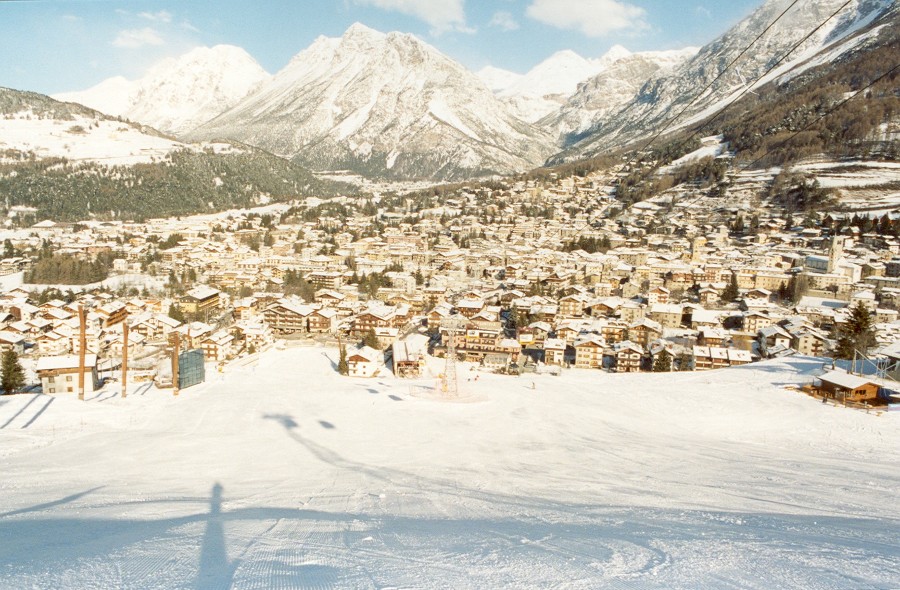
Our lodging is the Hotel Nevada, a small hotel sitting next door to the main Bormio 2000 (meters) gondola. It is conveniently a ski-in, ski-out place to stay. The hotel is hosted by two of the sweetest, long-haired, snow-white Samoyed dogs I have ever encountered. I vow to own at least one in the future. The canine pair spends all day lounging in the lobby or sleeping next to a door (in hopes of being let out to frolic in the winter wonderland outside).
Old town Bormio is an ancient, medieval village with highly appealing, comfortably narrow streets, and alleys, graced with stone buildings and inlaid street and sidewalk bricks that are so small that they appear almost cobblestone-like.
By noon, the sun appears over the town, which creates a dazzling, electrifying view of the snow-capped mountains wrapping snugly around the little Italian village in the valley.
The streets, despite the sloshy, snowy conditions, are bustling with pedestrians.
Lunch is at the Trattoria Ristorante, which sits on the exceptionally picturesque Piazza Cavour - a piazza that terminates the stupendous Via Roma pedestrian shopping street.
I dine on a scrumptious, signature Bormio dish for lunch, and later at the hotel for dinner. A homemade buckwheat pasta with melted cheese, potato, cabbage and spinach.
That second night, the temperature plummets, the wind kicks up, and the slush ices over.
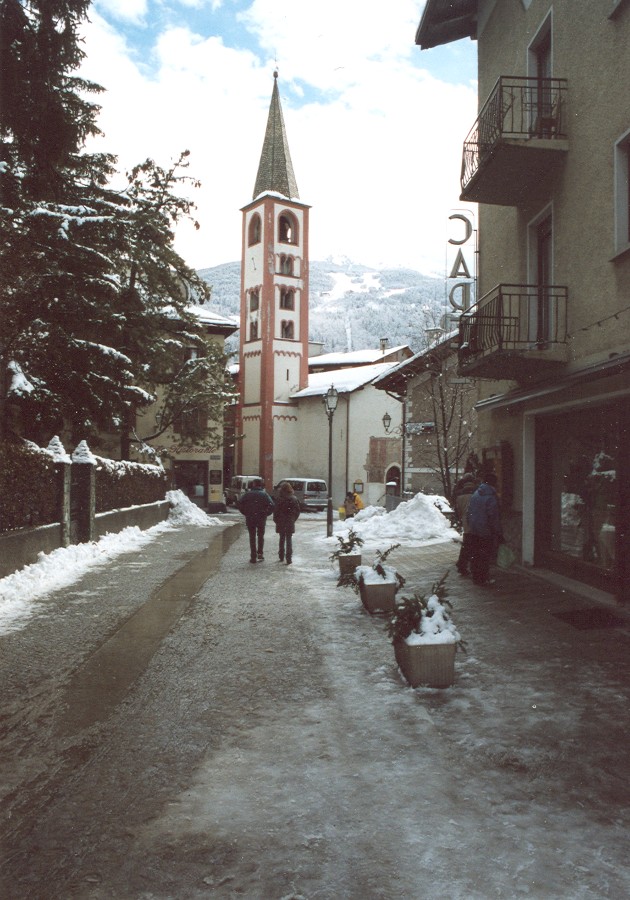
The next morning is crystal clear, and I can't wait to sample the Italian Alps.
The snow turns out to be understandably a bit crusty, but is mostly groomed, which becomes increasingly soft, fairly deep powder as the day wears on. Indeed, my perception is that the Bormio slopes (and other slopes later in the week) have the softest, silkiest snow I've ever skied. Not sure why that would be true.
While the ski conditions are surprisingly good, I quickly notice that the Bormio slopes are almost totally lacking in trail (or lift) signs, and the ones found tend to be on the small side for readability at a distance. Lift chairs are relatively comfortable here. I have my first experience with what amounts to a conveyor belt that carries skiers forward into position as a lift chair scoops up the skier. Took some getting used to at first.
My impression of the Bormio slopes is that the intermediate level trails tend to be steeper and somewhat more challenging than those I'm familiar with in Colorado, and many of the black diamond trails tend to be less demanding than those I've skied in Colorado. As a "strong intermediate" skier, this sets up a rather ideal situation for me. A recipe for mucho grande enjoymento.
Looking down from the top of the ski mountains, the mountains surrounding the valley are, in a word, staggering. The most spectacular, snow-capped peaks I have ever been in the midst of. As a result, on that first day of skiing, I was snapping photos of the magnificent mountains every time I have a moment between hurtling ski runs.
Lunch at Mario's Café on Bormio 2000 turns out to be impressively authentic. A real Italian treat for a ski lunch. I blissfully gobble down delicious, moderately priced polenta and gnocchi.
The grand finale on this first day is to go to The Top - Bormio 3000. The views, impossibly, are even MORE staggering.
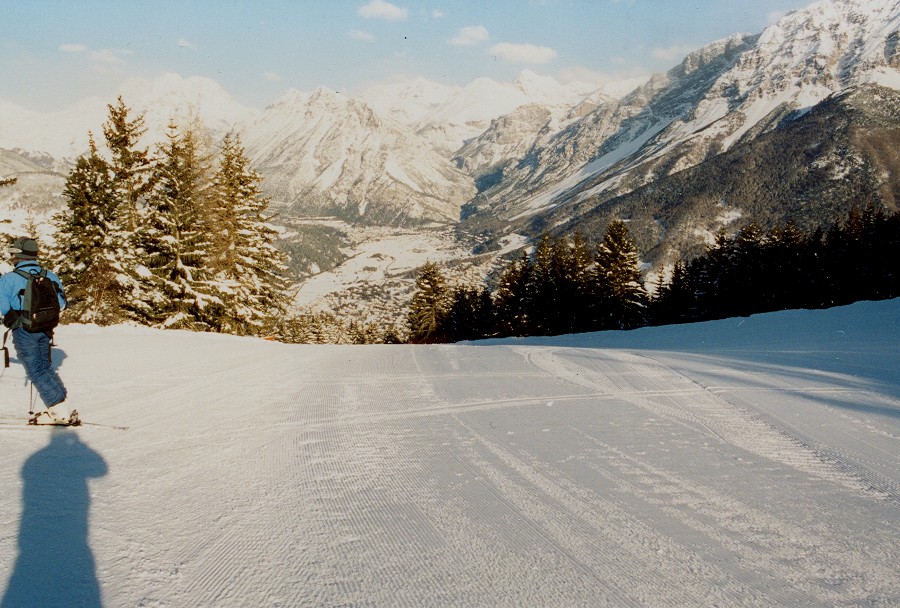
The slopes on Bormio tend to be forgively wide and fairly well-groomed on Bormio 3000. Not what one would expect at this nose-bleed elevation.
Skiing down from 3000 - while exhilarating - quickly froze my face and fingers to numbness - largely due to the blustery, fierce wind and bitter-cold air up here. I ski faster to speed my arrival at a place of warmth.
One of my runs this day turns out to be a rather steep intermediate. I later learn why. It was the venue for World Cup Ski Championships only a short time before our arrival.
Monday night after our hotel dinner, the 450 of us in Bormio from Florida assemble for a gala parade on Via Roma. I am, frankly, not expecting much from this event, but am pleasantly surprised.
Each in our Jacksonville group is carrying a American flag scarf. And we are all led by a local marching band. Many flank the street to greet us. Our march terminates at Piazza Cavour, where there are so many locals that it appears that the entire town has come out to happily greet us and dance with us.
There, the mayor and other local dignitaries officially welcome us. They serve us all the hot, spicy wine we can drink. All of us then spend the next several hours wildly dancing in the piazza and on the stage to both American disco and Italian folk (Bormio folk dancers also treat us to traditional folk dancing on stage as we watch).
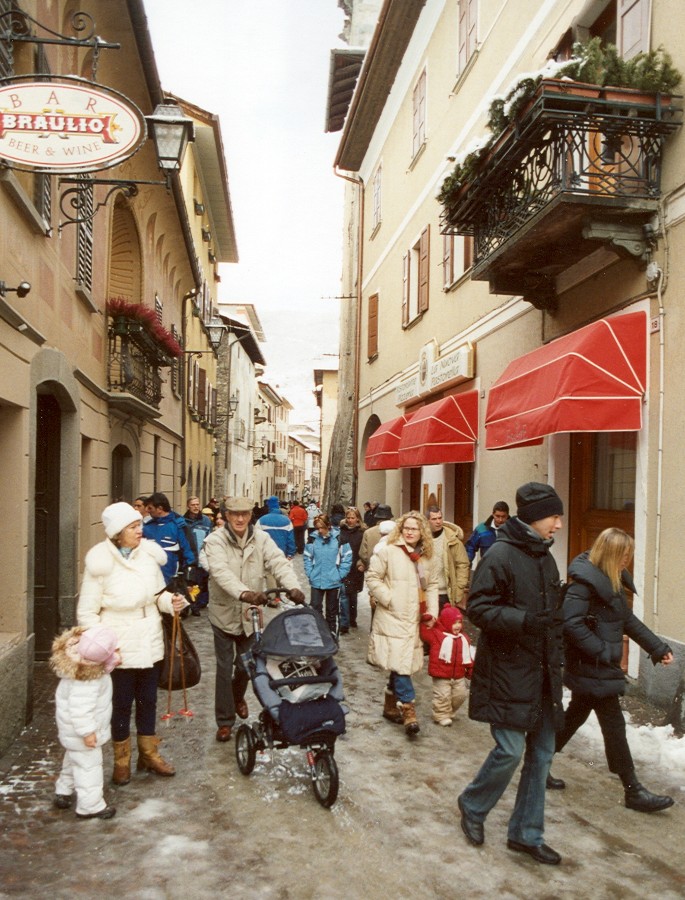
Flanking the piazza is a street that has been coated with snow to allow sledding and traditional wood ski skiing.
The next day finds me skiing the next mountain down from Bormio - Santa Caterina. On the way there, our shuttle bus passes through streets that seem too narrow to allow our bus to pass through (on a two-way street, I might add), but our driver skillfully negotiates through. Here, 3-story buildings butt up against the street. My knowledge of urban design has me observe the scene with quiet admiration, and regret that I do not live in such a quaint little town.
After my day of skiing Santa Caterina, I come to realize that no, skiing is not secondary to the Italian venue. The skiing, instead, rivals the quality of the Italian towns in my view.
Another unusual, somewhat challenging feature of the Italian (and later, Swiss) slopes I ski this week is the almost total absence of clocks. In America, they tend to be mounted prominently at each chair lift, but during my skiing here, I am regularly finding myself needing to ask someone nearby if they can show me the time on their watch.
On Wednesday, I sample a third mountain - Le Motte (pronounced "Le MOAT-ay"), Valdidentro, San Colombano. As our guide had promised a few days before, I have the mountain all to my own. Indeed, for the first time in my life, I am riding up a chair lift with over 200 chairs and appear to be the only person on any of the chairs.
On this day, I OWN this mountain.
Trails here are well-groomed, like Bormio and Santa Caterina. And like those mountains, the trails here tend to be quite steep at their terminus. Unlike the other two mountains, here the trails are fairly well-marked.
Overall, however, I find the skiing here to be slightly less exhilarating.
I finish the skiing by getting an enormous free lunch courtesy of the Florida Ski Council on Bormio 2000.
To conclude another fabulous day, we are bused to a famous Roman Baths facility ("Bagni Di Bormio") just outside of Bormio. The complex is a veritable labyrinth of small rooms containing every imaginable warm-water (heated by volcanism) therapy. Saunas, steam rooms, hot water jet rooms, mud baths, "relaxation" rooms, "mood" rooms, a pool room with large and therapeutic stones on the floor, an outdoor swimming bath (which we enjoyed as a fairly heavy snow fell on us).
A set of hot water rooms have waterfalls of warm water that crashes down on your back and neck, providing an outstanding massage. So good that it is the only room I go back to for seconds.
To finish, I ceremoniously don the white, terry-cloth, hooded robe they have given us and walk outside, monk-like, to a small out building. Inside, there are two ancient and ORIGINAL Roman stone baths that were once used during the Roman Empire, and continue to be available today.
I could almost sense what it was like in ancient times, sitting in the steamy, dark stone room, to be a Roman Centurion, seeking rejuvenation from the stress and injuries of fighting wars for the Empire.
Completely, utterly stress-melting experience. An unforgettable, blissful joy so fantastic that I tell others I'd give serious thought to coming again to Italy just to experience the baths. Don't miss them. As they say, it as if the skier has died and gone to skiing heaven.
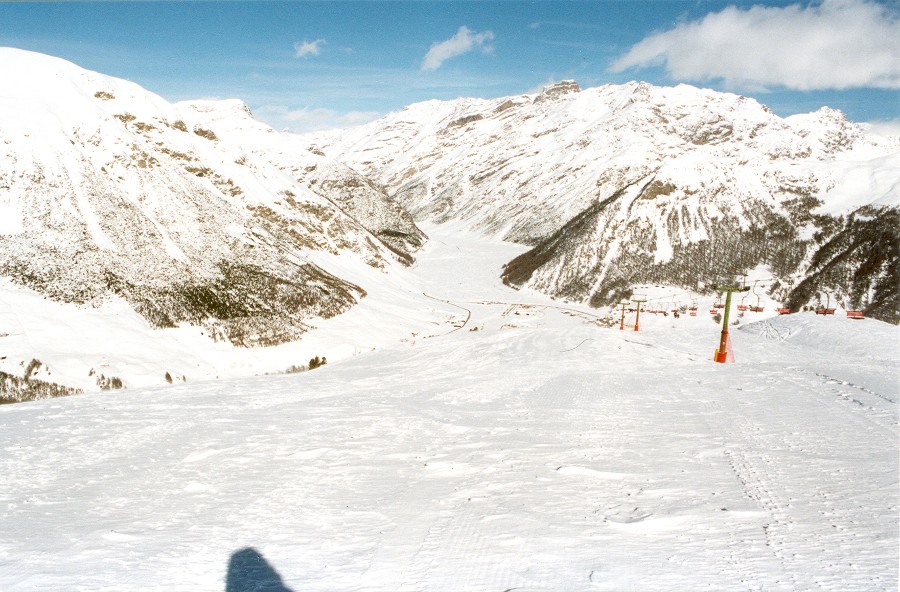
As we leave, there is a very soft, quieting, peaceful, gentle, romantic snow falling over us in Bormio. The fresh snow glistens in the street lights.
Livingno (pronounced "Liv-EEN-yo") is our Thursday group destination and it starts ugly. Like Saturday and Sunday morning, the heavy snow has not let up from the night before as our bus groans slowly up the narrow mountain road. The forecast we get from our guide "Verona" is grim conditions all day.
The bus ride is a white-knuckle ride as our driver needles the bus along the horrifyingly narrow, fresh-snow (read: slippery) road switch-backing and snaking up the mountain side (with a steep drop plummeting down hundreds of dark forest feet on our shoulder-less left).
The bus stalls as the driver shifts into second gear. He restarts it and it stalls again. And again. He calls the garage for rescue. We are to unload our ski gear and transfer to a functioning bus that has come for us. We now face inhospitable weather all day. We have lost at least an hour of ski time.
But miraculously, as we drive into Livingno on our new bus, the sky clears and the sun lights up the snowy slopes.
We spend all day skiing deep, fresh, virgin powder. Not my favorite conditions, but as the day wears on, I become increasingly (if slowly) more adept at this sort of skiing.
Like the other mountains, there are a modest number of trails to ski, but the powder creates a very enjoyable ski day. One of the best trails, starting at one of the highest peaks at Livingno, is called BellaVista, an exceptionally appropriate name for a trail with jaw-dropping views. I end up shooting about 15 photos on BellaVista due to its breathtaking nature.
Our day, delightfully, shifts from the slopes on one side of the Livingno valley to slopes on the facing side across the valley. Apres at the end of the runs appears to be an extremely popular pastime at Livingno, as there are an enormous number of sun worshipers and partiers at the outdoor cafes facing the slopes.
Crack of dawn the next day, our bus departs. Destination: The prestigious St. Moritz resort in the Swiss Alps. St. Moritz is a few hours north of Bormio and nestled within the legendary Swiss Alps.
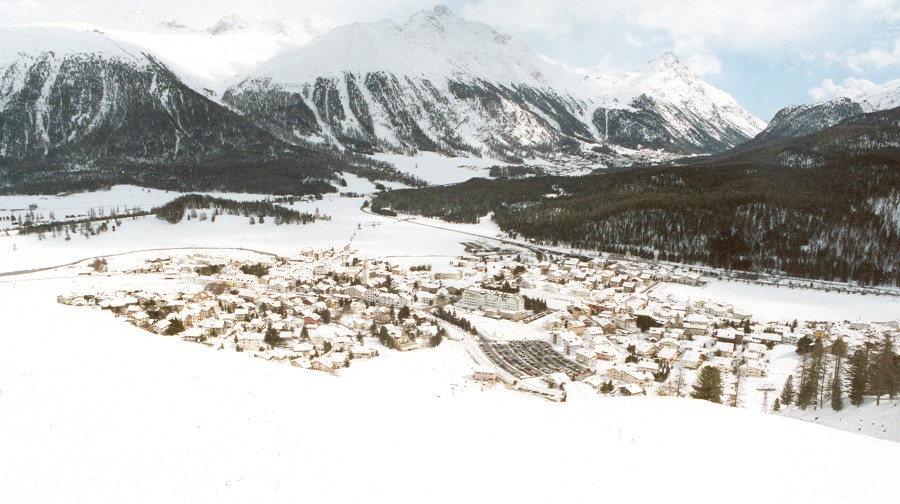
Our group information prior to the trip to St. Moritz was that this optional trip was a bit pricey and perhaps not worth it.
We were therefore unprepared for how worthwhile it turns out to be. St. Moritz valley is a gorgeously picturesque, cute little Swiss village full of clock towers and spires, as were the Italian villages in the region. The streets, again, are wonderously human-scaled, adding a very quaint, ancient feel to the village.
Many of the hotels in town are enormous and proudly ornamental.
The resort is very classy - particularly the gondolas. Only a few gondola cars are run, but each holds approximately 125 skiers.
Once again, the lack of signs, arrows or clocks lead to a bewildering experience, but the skiing is so lovely that one is easily able to overlook this. (Curious that Switzerland, a nation with a world-wide reputation for crafting the most sought-after watches in the world, would be so lacking in ski resort clocks…)
The lift lines, despite the world-wide fame of St. Moritz, are reasonably moderate in size. The slopes are relatively wide, fairly well-groomed, and tree-less, due to our being above the tree-line, with names such as Lanigiro, Alpina, Marmotta, Schtattain, and Akademiker.
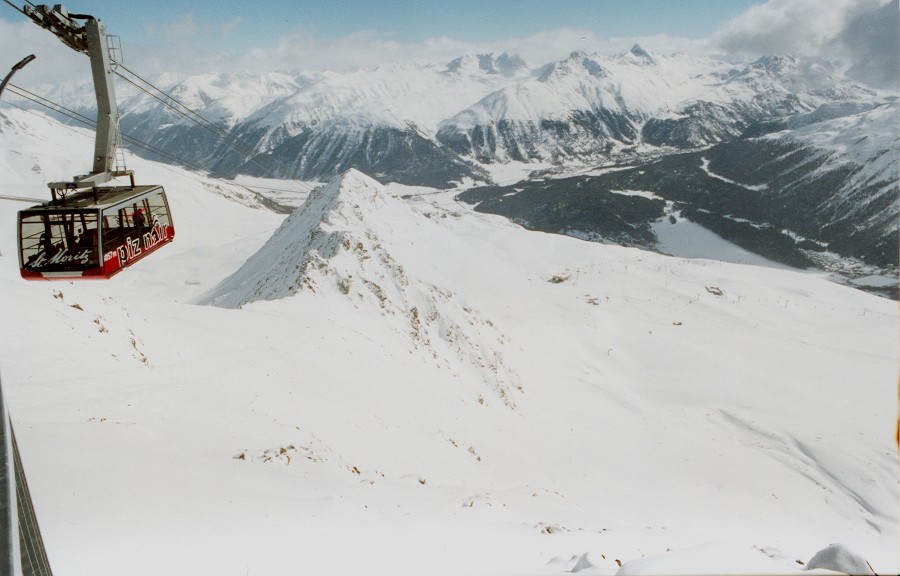
The thick layer of fresh snow has blanketed the slopes, and without the trees creates an other-worldly, lunar-like experience. Nearly pure white. What I imagine it would be like to ski Antarctica.
Perhaps the most astonishing aspect of St. Moritz is not so much the skiing (although skiing here is much better than average). No, the most unforgettable reward of St. Moritz, which makes it such a worthwhile visit, is the utterly breathtaking views. Head-shaking vistas of the snow-covered peaks and valleys. I shoot a great many photos. Soon, I regret that I had not brought 15 rolls of film to St. Moritz, instead of one.
I would shoot a photo of the most incredible view I have ever seen, ski around a corner just ahead, and come upon a vista before me that is EVEN more spectacular.
Mesmerizing.
Now I fully understand why the Alps are so legendary.
Fittingly, our final night in the Alps, to conclude a week of sheer bliss, is a WILD dance party at a hall in Bormio. Again, it appears that most of the town of Bormio has come to bid us arrivaderci , and they do so grandly, as we are treated to a great deal of wonderful vino. This time, the vice-mayor and the tourism director serenade us and toast us.
Being Italian, they show their hospitality by serving us steaming hot, fresh, al dente penne pasta in a delicious sauce, which I gobble between frenzied dancing. At first, they are subtle in serving us from the side of the hall, but then dressed in traditional Italian folk mountain attire, they weave amongst us to serve us the manna with their gargantuan-sized pasta caldron.
As the 7-day trip comes to an end, I think back and realize: "The week was so enjoyable that it has passed in the blink of an eye."
More than once, I think to myself, "There would be worse things than missing the bus back to Milano the next day to fly back to the US, or losing my passport. I could enjoy living here." "Didn't I have a one-way ticket from Jacksonville?"
A few weeks before our trip, I had read a news report about a recent global warming study indicating that within approximately 50 years, there will be very few, if any, remaining places to ski.
I resolve to ski as much as I can in the short time we have.
Preferably in the Alps...
Back to Dom's Voyages and Adventures page.